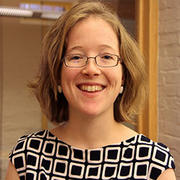
On Wednesday, February 24, Melissa Coles, an MDiv candidate at Harvard Divinity School and resident at the Center for the Study of World Religions, presented "Pilgrimage in Ireland: Walking the Paths: A Wee Taste of a Few Tales."
In her presentation, Melissa utilized an experiential approach in order to bring the pilgrimages to life and provide an enduring introduction to them. Her PowerPoint consisted of 150 images from five Irish pilgrimages that she completed.
In June-August 2010, Melissa embarked on pilgrimage research in Ireland as part of her anthropology major at the University of Notre Dame. During her research, Melissa's main methodology included participant observation, archival research, and interviews. During her presentation, she focused on the participant observation aspect of this work—especially highlighting her own personal experiences.
The first pilgrimage Melissa discussed was Croagh Patrick, a holy mountain in County Mayo with a religious significance going back to St. Patrick (and even further). Thousands of people climb Croagh Patrick/ the Reek each year, especially on Reek Sunday, the last Sunday in July. Melissa described in vivid detail walking the Tóchar Phádraig (a 22 mile pilgrims' path from Ballintubber Abbey to Croagh Patrick) on Reek Sunday. She then described returning to Croagh Patrick to climb the mountain in the traditional penitential way: "in her feet" (barefoot). Croagh Patrick is a raw, nature pilgrimage site that inspires, humbles, and awes pilgrims.
Next, Melissa described Knock, a Marian Apparition site in County Mayo. The 1879 Apparition of Mary, St. Joseph, St. John the Evangelist, and a Lamb and cross on an altar is an officially recognized Apparition by the Catholic Church. Knock is an internally renown pilgrimage, and Melissa saw the reason why when she approached the site of the Apparition. There, the holiness of the site was strikingly palpable. The air felt thick, heavy, holy, blessed, warm, comforting.
Shifting away from current pilgrimage sites to discuss an older pilgrimage, Melissa described traveling to Skellig Michael, an island 7.5 miles off the coast of County Kerry. Skellig Michael was the site of extreme monasticism; from the sixth through the thirteenth centuries, ascetics built their monastery on the remote heights of the wind-swept crag. After they returned to mainland Ireland, the island remained a place of pilgrimage. Today, people travel to the island for various reasons, including: spiritual, bird-watching, and historical reasons.
The next pilgrimage Melissa discussed was the Sanctuary of St. Patrick, Lough Derg. Located in County Donegal, Lough Derg, like Croagh Patrick, is an ancient pilgrimage site associated with St. Patrick. Similarly, Lough Derg also features strong nature elements, for it is an island in the middle of a lake. There used to be a cave on the island, and St. Patrick (followed by thousands others) went to meditate in the cave because he saw visions of those in Purgatory there. The cave is long gone, but the pilgrimage history of Lough Derg has endured. Hundreds travel to St. Patrick's Purgatory each year to attend intense but fulfilling one- and three-day pilgrimages.
Finally, Melissa described and discussed the annual pilgrimage to Inis Caher, a small island five miles off the coast of County Mayo. In contrast to the other pilgrimages, the Inis Caher pilgrimage is local. The Catholic nature of the island goes back to at least the seventh century, when a monastery was founded there. Inis Caher, like Skellig Michael, played an active role in the early Christian and medieval landscape as an island monastic site. After the monks left the monastery and traveled to the mainland, the island became a pilgrimage site. People from the region travel by boat to the island each year to visit Tobermurry (a holy well), hold mass in the monastic ruins, and then celebrate on a neighboring island.
Melissa concluded her presentation with a lively Q&A session. During the Q&A, topics included: the interreligious history of the pilgrimage sites, the usage of sound on the pilgrimages, pilgrim demographics, and the sheer beauty of Ireland. Several CSWR residents expressed the desire to now travel to Ireland to walk the ancient paths themselves. Thus, Melissa's experiences on Irish pilgrimages were brought to life and also, through the newly inspired future pilgrims, given new life.
